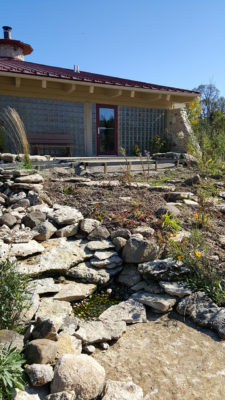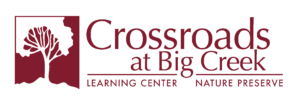Crossroads Is Going to the Birds (and Butterflies)
- Share
- Tweet
- Pin
- Share

Crossroads at Big Creek welcomes another season of providing lifelong experience-based learning on science, history and environment with the unveiling of its newest addition: an accessible bird and butterfly garden.
Situated around the Collins Learning Center, the bird and butterfly gardens will enhance the organization’s mission of connecting people of all ages and abilities with nature at close range while also attracting native birds, butterflies and pollinators to the 200-acre preserve.
Coggin Heeringa, executive director of Crossroads, explained the project partially originated as the be-all and end-all solution to a number of safety and water issues Heeringa and Crossroads Land and Facilities Manager Rich Propsom had identified around the building.

The restroom entrance during sidewalk construction last year. Submitted photo.
In particular, the addition of ADA-approved walkways and patios outside of the building’s two side exits addressed accessibility and safety concerns while the installation of a dry stream, bog-like retention pond and a pebble pond will aid in stormwater mitigation by channeling or retaining water that would otherwise end up on Crossroads’ new parking lot expansion. These water features will also serve as a drinking and bathing source for birds and insects, and with the addition of dark rocks, a place for butterflies to bask in the sun.
With the support of the Crossroads board, staff members were able to secure a number of grants and donations to fund the approximately $12,000 project, which began in the spring of 2016 with hardscaping and creation of the water features. It continues this year with the transplanting of native plants – selected from throughout the preserve’s 200 acres – to bring native birds, butterflies and caterpillars to an area accessible to all visitors.
To increase the numbers and types of caterpillars and butterflies that call Crossroads home, Heeringa and Propsom relied on relatively new research that shed light on butterfly plant preferences.
“Almost every butterfly, almost every moth has one specific plant that it will lay eggs on and if you don’t have that kind of plant, you won’t have that kind of butterfly,” Heeringa explained.
By using Crossroads’ native plants, they will have a head start on developing the gardens while also avoiding neonicotinoids (a class of insecticides often found in nursery stock). Native trees will also be transplanted into the small gardens.
“Most butterflies use trees so we’re going to have to bring in native trees and because they’ve co-evolved, you can’t bring in a tree from Europe or Asia or any of the cultivars or anything like that. You have to have native trees for native butterflies,” Heeringa said. “Well, it turns out 90 percent of our songbirds feed their babies exclusively caterpillars so if you don’t have butterflies, you will have a decrease in bird populations.

This dry stream carries water from the roof of the Collins Learning Center and provides water for birds and butterflies. Submitted photo.
“Even ones you think of as seed-eaters, they need protein,” she added. “Sunflower seeds are not going to raise a baby chickadee – 9,000 caterpillars will raise a baby chickadee. It’s really that big of a number. We want chickadees.”
When chickadees begin to call the gardens home, Heeringa has plans to train them to hand-feed, which leads her to two more goals of the bird and butterfly gardens: to serve as a destination place (particularly for the mobility impaired and families with small children) and as a demonstration garden for gardeners.
“We want people to come here and think, oh, I could put that in my garden…I don’t have to have all my plants in a row with bark between them, I could make it a little more dense. I could do this,” Heeringa said. “That’s what a demonstration garden is. Someplace where people come and say, ‘I could do that.’
“By the time we’re done, it should be so thick that you can’t see the ground,” she added. “It’s going to be lots and lots of plants and butterflies and birds.”
In that respect, the bird and butterfly garden is already working. This winter, Heeringa and the Crossroads staff let the skeletons of last year’s greenery overwinter to serve as an important lesson on overlooked habitats.
“It looks really horrible right now because we left all our plant stalks. Native bees don’t have hives, they live in the hollow stems of dead plants in the wintertime so if you clean up your garden, you take out all their winter homes…in fact, a lot of people put the pile of clippings really near because they’re all filled with insects then,” she said. “Some of the birds go into your brushpiles and get the insects out of those early on. So you don’t want to clean your garden early, you really don’t. You want to leave it ugly.”
Crossroads at Big Creek is located at 2041 Michigan St. in Sturgeon Bay. For more information, visit CrossroadsatBigCreek.com.


